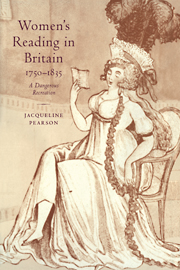Book contents
- Frontmatter
- Contents
- Preface
- Introduction
- 1 Pygmalionesses and the pencil under the petticoat: Richardson, Johnson and Byron
- 2 What should girls and women read?
- 3 The pleasures and perils of reading
- 4 Pleasures and perils of reading: some case histories
- 5 Where and how should women read?
- 6 Preparing for equality: class, gender, reading
- 7 A dangerous recreation: women and novel-reading
- Conclusion
- Notes
- Select bibliography
- Index
2 - What should girls and women read?
Published online by Cambridge University Press: 22 October 2009
- Frontmatter
- Contents
- Preface
- Introduction
- 1 Pygmalionesses and the pencil under the petticoat: Richardson, Johnson and Byron
- 2 What should girls and women read?
- 3 The pleasures and perils of reading
- 4 Pleasures and perils of reading: some case histories
- 5 Where and how should women read?
- 6 Preparing for equality: class, gender, reading
- 7 A dangerous recreation: women and novel-reading
- Conclusion
- Notes
- Select bibliography
- Index
Summary
When Dr Johnson visited Frances Sheridan and found her daughter ‘attentively employed in reading his “Ramblers”’, Sheridan was more anxious than proud, and ‘hastened to assure’ him that the girl was allowed only ‘unexceptionable’ books, and that she was ‘very careful to keep from her all such books as are not calculated, by their moral tendency, for the perusal of youth’. Johnson disagreed: ‘“Then you are a fool, madam! … Turn your daughter loose into your library; if she is well inclined, she will choose only nutritious food; if otherwise, all your precautions will avail nothing to prevent her following the natural bent of her inclinations.”’ Sheridan is more typical of the age than Johnson, and this was even more marked by 1824, when her granddaughter Alicia Lefanu described Johnson's opinion as ‘injudicious and dangerous’, for ‘the practice of indiscriminate reading’ would obviously teach the child ‘immoral precepts’. Although this narrative does not seem to be gendered – age, not gender, seems the criterion of suitability – gender was surely a significant unspoken element. Contemporary comments are always more anxious about female than male reading, and accounts of girls’ reading, including the family history of the Sheridans and Lefanus, repeatedly emphasise the need for restriction.
However much commentators differed in detail, virtually all thought women's reading mattered, for society as well as individuals. In 1814 Laetitia-Matilda Hawkins denied ‘that books produce no effects’, certain that reading ‘censurable’ books ‘can do … harm’.
- Type
- Chapter
- Information
- Women's Reading in Britain, 1750–1835A Dangerous Recreation, pp. 42 - 86Publisher: Cambridge University PressPrint publication year: 1999



